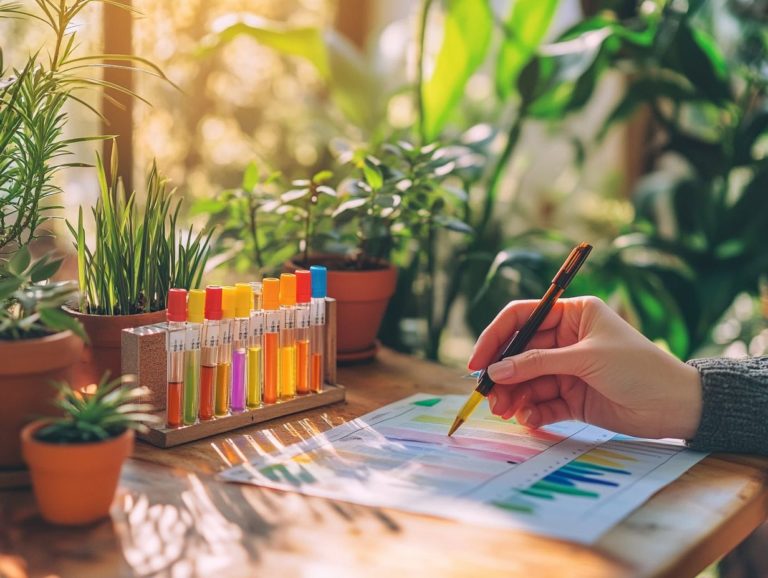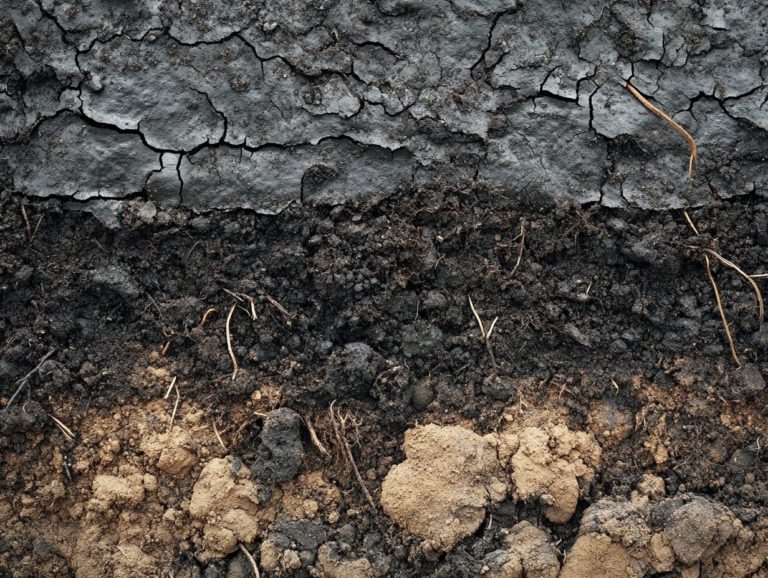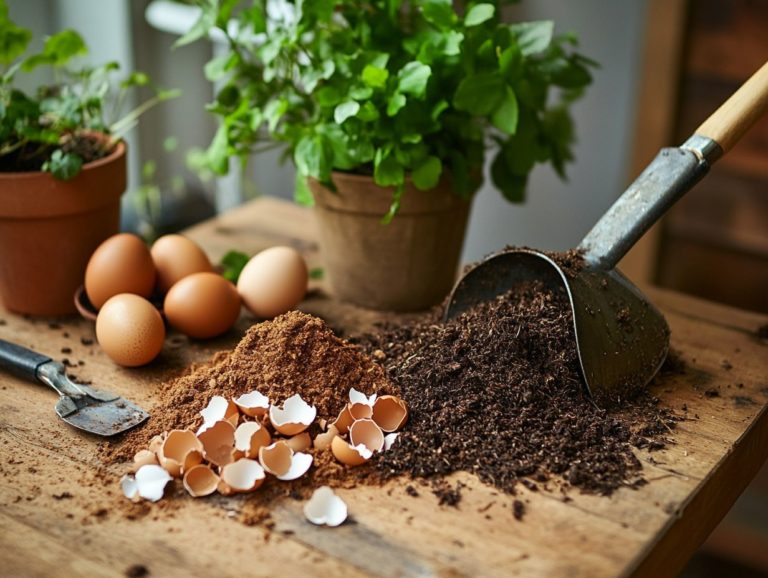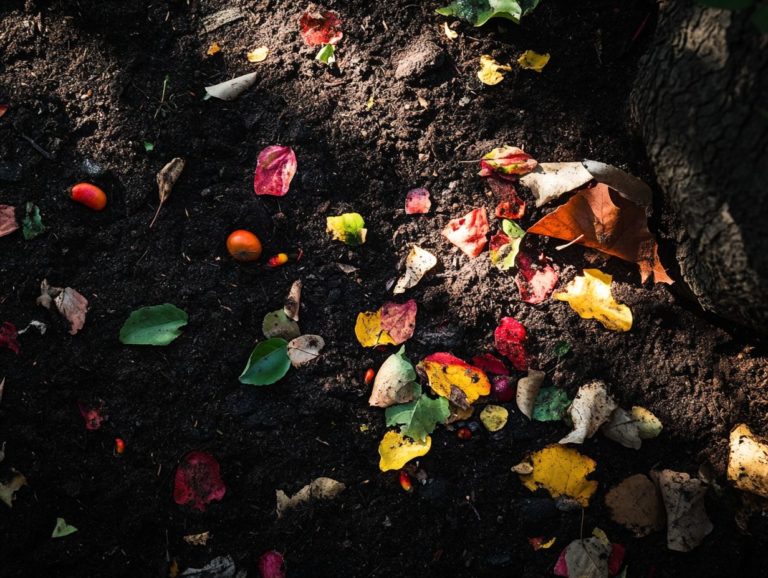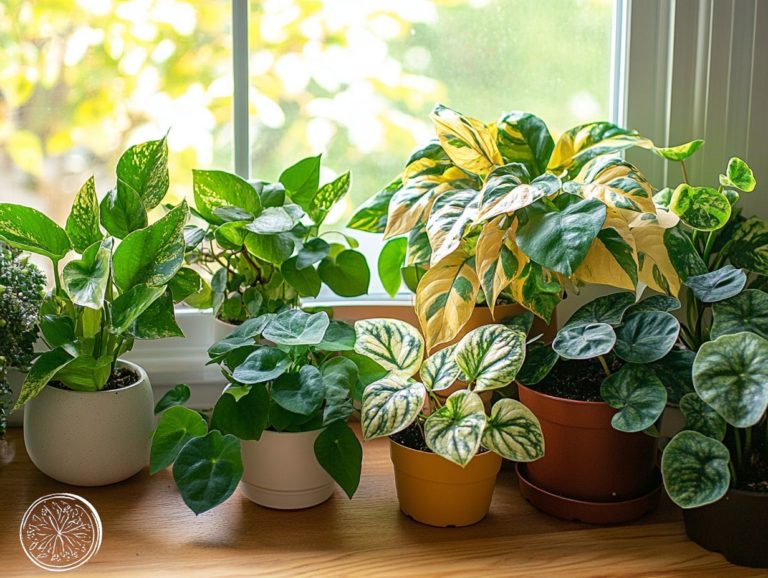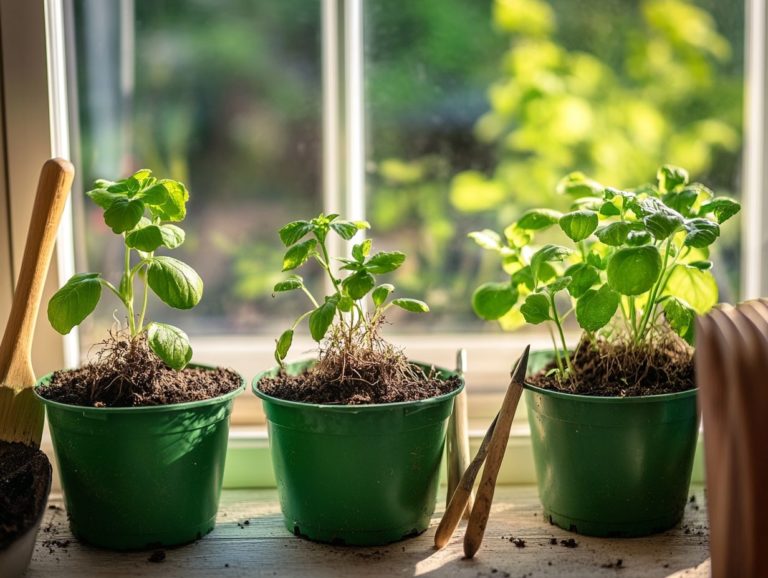How to Identify and Treat Soil of Indoor Plants
Healthy soil is the cornerstone of flourishing indoor plants! Many plant owners often underestimate its vital importance, especially when managing root rot.
Recognizing the signs of unhealthy soil like poor drainage or nutrient deficiencies is essential for nurturing your green companions. Look for symptoms such as yellow and wilted leaves.
This guide will help you discover solutions to common soil issues that can help your plants thrive! We ll cover effective treatment steps, preventive measures, and pest control methods for managing soil gnats.
You’ll also learn how to select the right potting soil tailored to your indoor plants’ needs. This ensures optimal moisture retention and nutrient management.
Immerse yourself in this knowledge and uncover the secrets to cultivating a vibrant indoor garden that celebrates healthy roots and thriving plants!
Contents
- Key Takeaways:
- Identifying Soil Issues
- Treating Soil Issues
- Choosing the Right Soil for Indoor Plants
- Frequently Asked Questions
- What are some signs that my indoor plant’s soil needs to be treated?
- How can I identify what type of soil my indoor plant has?
- What are some common treatments for indoor plant soil?
- How often should I treat my indoor plant’s soil?
- Can I reuse soil from my indoor plants?
- What are some natural remedies for treating indoor plant soil?
Key Takeaways:
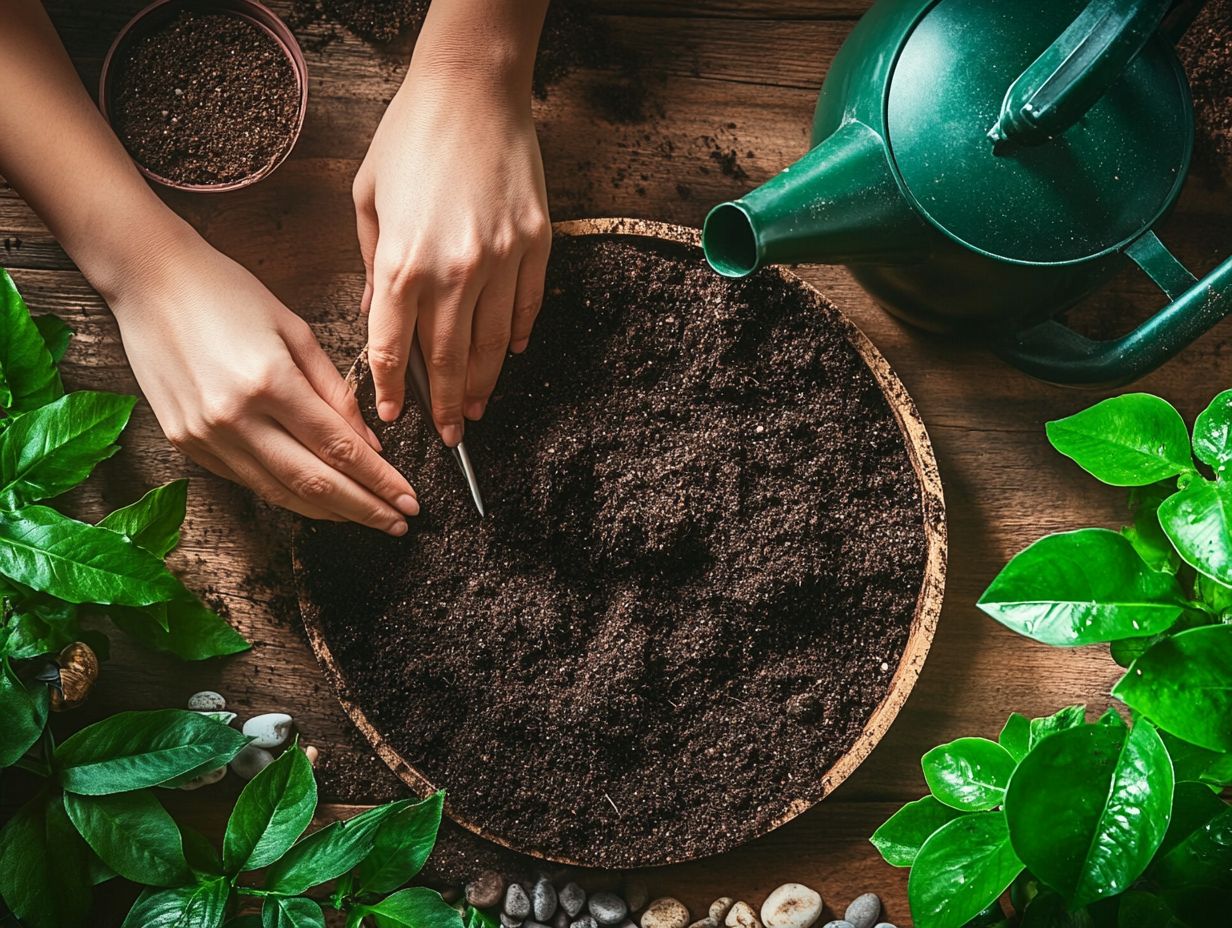
- Healthy soil is crucial for the growth and wellbeing of indoor plants. It provides nutrients, aeration, and drainage.
- Signs of unhealthy soil include waterlogged or dry soil, stunted growth, yellow leaves, and the presence of pests like fungus gnats. Common problems include over-fertilization, compacted soil, and acidity imbalances.
- To improve soil quality, add organic matter like composted bark, aerate, and adjust soil acidity. Preventive measures like proper watering and avoiding chemical fertilizers can also help. Choose soil based on plant needs, potting mix quality, and drainage capabilities.
Importance of Healthy Soil for Indoor Plants
Healthy soil is vital for flourishing indoor plants. It provides essential nutrients and moisture needed for optimal growth and resilience against pests.
Managing nutrients is vital. The right balance helps plants grow strong and ensures healthy development.
The soil s ability to retain moisture without becoming waterlogged is equally important. This helps you avoid overwatering, which often leads to root rot, a condition where plant roots decay due to excess moisture.
Using a quality potting mix tailored to the specific needs of your plants, along with maintaining a slightly acidic to neutral acidity level, helps their roots thrive in well-conditioned soil. Healthy roots create a strong foundation, translating into resilient plants capable of withstanding environmental stresses.
Identifying Soil Issues
Identifying soil issues is crucial for preserving the vitality of your indoor plants. Symptoms like yellowing leaves or wilting often indicate underlying concerns, such as overwatering, poor soil conditions, or root rot.
By recognizing the signs of unhealthy soil, like the presence of soil fungi, you can take proactive measures before these problems escalate. This ensures your plants maintain the robust roots essential for thriving.
Regularly inspect drainage holes and monitor soil moisture levels. Catching potential issues early whether it s soil gnats, root rot, or waterlogged conditions safeguards the health of your cherished plants.
Start identifying soil issues today to keep your plants healthy and vibrant!
Signs of Unhealthy Soil
Signs of unhealthy soil are hard to miss: yellow leaves, wilted foliage, and other telltale signs that your indoor plants aren t thriving. These symptoms usually arise from managing how wet the soil is or inadequate drainage, creating a perfect storm for root rot.
As an indoor gardener, it s vital to pay close attention to these visual cues. Don t wait until it s too late! Monitoring moisture levels and ensuring proper drainage in your decorative planters can make a world of difference for plant well-being and help prevent growing weeds.
Beyond the yellowing and wilting, keep an eye out for stunted growth, leaf drop, and even a foul smell coming from the soil these can all signal deeper issues. If the soil feels overly compacted or seems to hold onto too much water, consider it a red flag for poor drainage that can suffocate roots and invite fungal diseases.
A crusty top layer masking soggy soil beneath? That s a recipe for inconsistent moisture levels, which only adds stress to your plants. Recognizing these adverse conditions allows for timely intervention, enabling you to cultivate a healthier environment for your beloved greens.
Common Soil Problems
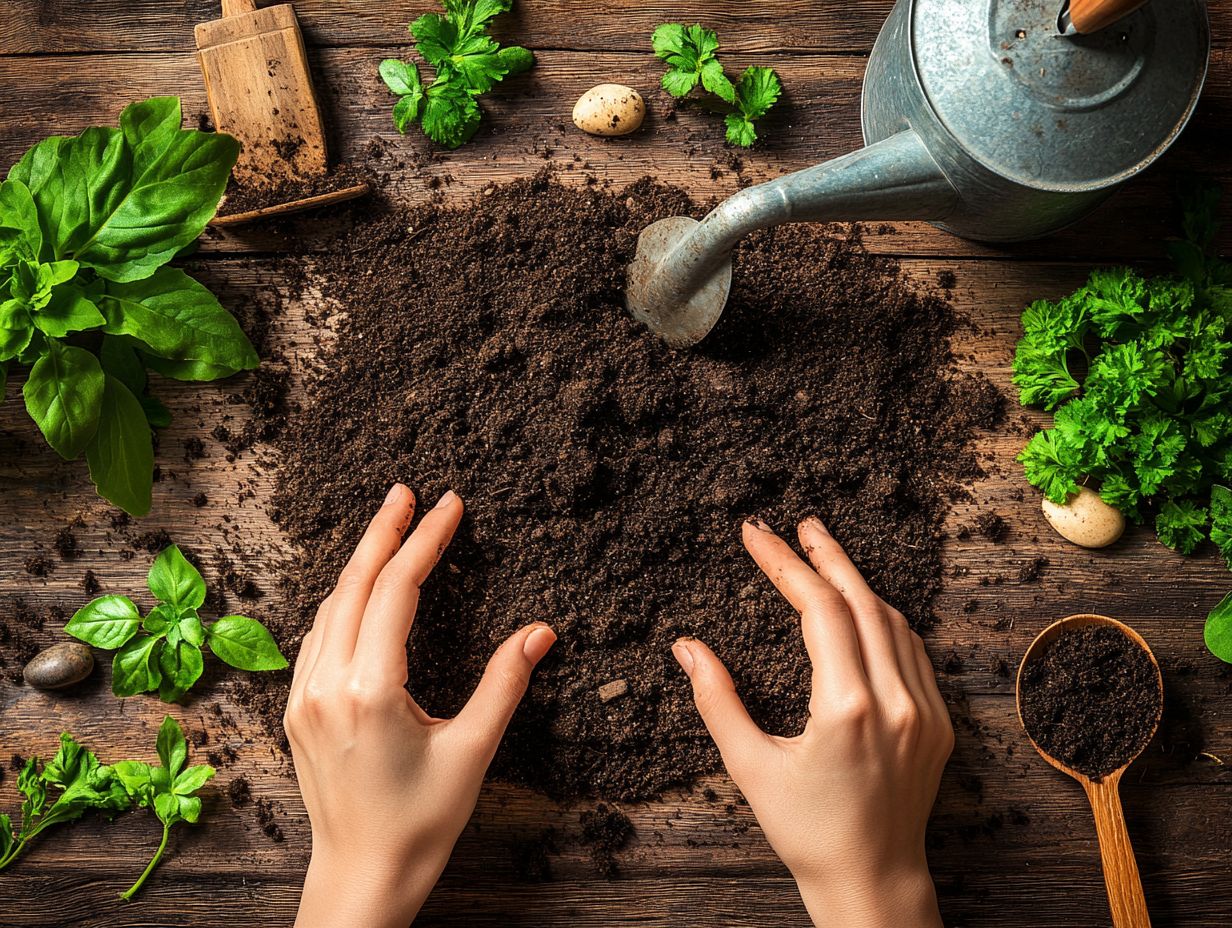
Common soil problems that affect indoor plants often stem from issues like root rot, fungus in the soil, and overwatering. These factors disrupt healthy growth and can lead to a decline in your plants’ health.
By recognizing these soil issues early, you can intervene promptly. This helps maintain optimal soil drainage and prevent pest infestations.
Understanding the root causes of these problems enables you to take proactive measures, including adjusting watering habits and ensuring proper drainage, to create a thriving environment for your plants.
Excessive moisture can turn your soil into a breeding ground for harmful fungi, weakening the roots and diminishing the overall vitality of your plants. Overwatering not only suffocates root oxygenation but also invites pests to join the party, compounding the issue.
Regularly check your watering habits to manage these conditions effectively. Ensure your pots have adequate drainage. Incorporating pest management practices, like introducing beneficial insects, can help deter harmful pests.
Amending your soil with organic matter can significantly enhance its structure and resilience against damage. By implementing these strategies and conducting regular soil tests, you lay a robust foundation for your indoor plants to thrive beautifully.
Treating Soil Issues
Fixing soil issues is key to helping your indoor plants thrive! By implementing treatment strategies like adding compost and soil amendments, you can markedly enhance soil quality, improve drainage, and promote robust root development.
Understanding your plants’ specific needs helps you apply targeted solutions that tackle soil moisture and nutrient deficiencies, creating an environment perfect for growth and vitality.
Regularly testing soil conditions will further refine your approach, ensuring your plants receive the utmost care they deserve.
Methods for Improving Soil Quality
Improving soil quality is crucial for your indoor gardening success, as it directly influences the healthy growth of your plants. By using soil amendments like compost and composted bark, you not only enhance holding nutrients but also promote aerated soil, allowing roots to breathe and thrive.
Regularly changing your potting soil and integrating organic materials can further bolster soil health. This ensures that your indoor plants flourish beautifully in their decorative planters. Understanding the specific needs of your plants will guide you in selecting the most effective methods, such as using top soil amendments for healthy indoor plants, for enhancing soil quality.
Incorporating ingredients such as peat moss and perlite can also help achieve the ideal balance of moisture retention and aeration. This balance is crucial for the best performance of your indoor garden. By leveraging these organic materials, you create an environment that fosters healthy root systems, effectively preventing issues like root rot and compaction.
Practicing mulching regulates soil temperature and moisture levels, promoting plant vitality. Together, these methods contribute to a thriving indoor garden, creating lush, vibrant displays that elevate any living space.
Preventing Soil Problems
Preventing soil problems is essential for maintaining the health of your indoor plants. It starts with ensuring proper drainage holes and keeping just the right amount of water.
Regularly monitoring your soil conditions and implementing pest control measures can safeguard against issues like root rot and pesky soil gnats. Embrace preventative strategies such as fine-tuning your watering practices and selecting the right potting soil to create a stable environment that nurtures healthy roots and flourishing plants.
To further enhance soil health, consider incorporating organic matter like compost. It works wonders for improving soil structure and boosting nutrient content.
Establishing a consistent watering schedule is crucial to preventing both overwatering and underwatering, which can jeopardize your plants’ vitality. Using mulch helps retain moisture and suppress weeds, allowing your roots to thrive without competition for resources, promoting healthy growth.
Regularly inspecting your plants for pests and diseases enables timely interventions. This ensures that your indoor environment remains a safe haven for growth. By prioritizing these strategies, you can effectively nurture your plants while minimizing potential soil challenges.
Choosing the Right Soil for Indoor Plants

Choosing the right soil for your indoor plants is essential for their growth and overall health. It involves understanding the various types of potting soil and how they meet the specific needs of different plants.
The ideal soil must provide the necessary nutrients, retain moisture, and offer adequate aeration to support robust root development. As you select soil formulations, keep in mind the unique requirements of your plants, including their light levels and humidity preferences.
By managing nutrients effectively and conducting regular assessments, you can create an environment where your plants truly thrive.
Factors to Consider
When selecting soil for your indoor plants, consider several key factors. These include soil pH, how well soil holds water, and the specific needs of your plant species.
Understanding these aspects helps create the perfect environment for your plants. This encourages healthy growth and helps avoid common soil-related issues.
Keep an eye on pH levels. Opting for a potting mix that aligns with your plants’ requirements ensures they receive essential nutrients for thriving indoors.
For example, the pH level of the soil significantly impacts nutrient availability. Most indoor plants flourish in slightly acidic to neutral conditions, typically ranging from 6.0 to 7.0.
Moisture retention is another crucial element. Some plants thrive in well-draining mixes that dry out quickly, while others appreciate moisture-retentive soil that keeps their roots hydrated.
Understand your plants’ specific needs, such as light requirements and growth patterns. Choose the right soil to effectively support nutrient management.
Focus on these elements. This will help your indoor plants not just survive, but flourish.
Types of Soil and Their Benefits
There s a world of soil types available for your indoor plants, each offering unique advantages. These include improved nutrient retention and a beautifully aerated structure.
Potting soil blends often feature ingredients like composted bark and peat, essential for fostering healthy growth while managing moisture effectively.
By understanding the specific characteristics of different soil types, you can make informed choices that perfectly suit your indoor plants. This ultimately creates a vibrant and thriving indoor environment.
Take cactus soil, for instance it s designed with larger particles to ensure exceptional drainage, preventing the overwatering that can lead to root rot.
Then there’s seed-starting mix, which is lightweight and finely textured. This makes it ideal for encouraging germination and delicate root development.
If you re growing tropical plants, look for a mixture that includes coconut coir. It enhances moisture retention while still providing necessary aeration, creating the perfect habitat for their root systems.
Select the right soil type to provide your indoor plants with the support they need for robust health and flourishing growth. Understanding soil pH for indoor plants is also crucial for their overall well-being.
Frequently Asked Questions
What are some signs that my indoor plant’s soil needs to be treated?
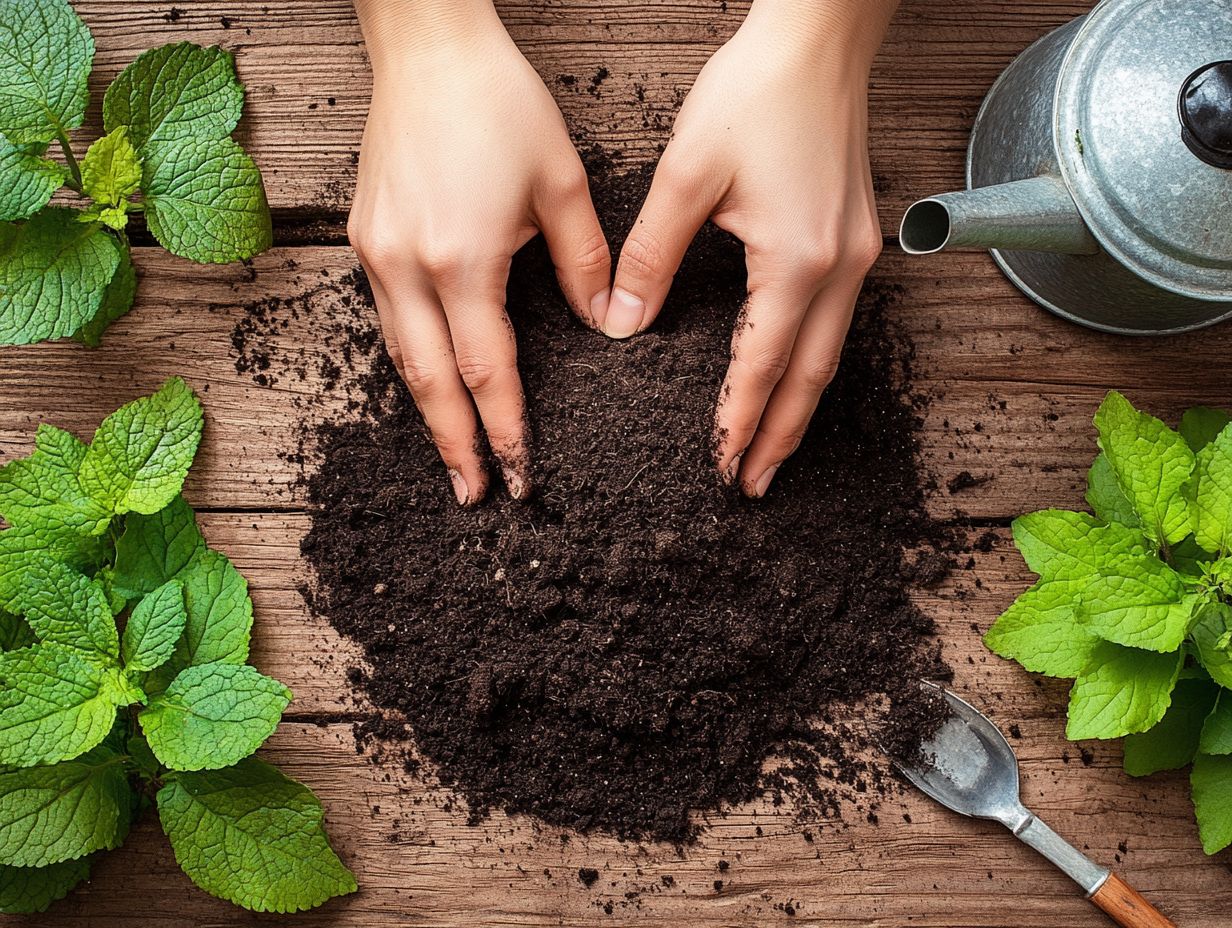
Look out for signs such as mold growth, a foul odor, and poor drainage. If you notice your plant’s leaves turning yellow or wilting, it may indicate that the soil is depleted and needs treatment.
How can I identify what type of soil my indoor plant has?
The best way to identify your plant’s soil is by conducting a simple soil test. You can purchase a test kit or take a sample to your local gardening center for analysis. Knowing the pH level and nutrient content helps determine how to treat it.
What are some common treatments for indoor plant soil?
Common treatments include adding fertilizers, changing the soil mix, and aerating the soil. Adding organic matter, such as compost, improves the soil’s texture and nutrient content.
How often should I treat my indoor plant’s soil?
The frequency of soil treatments depends on your plant type and its individual needs. Generally, treat indoor plant soil every 6-12 months to replenish nutrients and maintain a healthy growing environment.
Can I reuse soil from my indoor plants?
Yes, you can reuse soil, but it’s important to treat it properly before using it again. This includes removing dead plant material, aerating the soil, and replenishing nutrients by adding fertilizer or organic matter.
What are some natural remedies for treating indoor plant soil?
Natural remedies include using crushed eggshells for added calcium, coffee grounds for nitrogen, and cinnamon to prevent mold growth. Compost or manure can also be used as organic fertilizers.

